On the morning of May 20th, I set out from Mysore to the JLR Kings Sanctuary1, an eco-lodge a stone’s throw from the edge of Nagarahole National Park and Tiger Reserve. Once a hunting preserve of the Wodeyar dynasty, Nagarahole has become one of the premier protected areas in Asia, with some of the highest-density tiger, Asian elephant, and wild gaur populations in the world. It’s also been a crucible of conservation innovation: Dr. Ullas Karanth, renowned conservationist and father of current Centre for Wildlife Studies leader Dr. Krithi Karanth, conducted much of his early tiger research in Nagarahole. In more recent years, the modern CWS began its pioneering human-wildlife coexistence programs, Wild Seve, Wild Shaale, and Wild Surakshe in the “buffer zone” landscapes surrounding Nagarahole.
I had plans to meet up with the local CWS team and learn more about their work2, but first I was going to experience the national park myself. Around 3:30 PM on May 20, I piled into a Jeep alongside other JLR Kings Sanctuary visitors, and we set off on my first-ever classic-style safari. Even as other parts of Asia experienced extreme heat, this part of South India was overcast with occasional unseasonal showers of rain, so temperatures were positively pleasant.
Within minutes of traversing the park gate, I was grinning from ear to ear, relishing the full-body thrill of being in such a manifestly life-rich ecosystem. Great teak and sandalwood, trees anchored the spreading canopy of the forest, with the undergrowth growing thicker and the patches of grassland growing lusher as our path proceeded inwards. Red jungle fowl, the wild ancestor from which chickens were domesticated, pecked along the verges of the road, and wild peacocks occasionally called from trees and verges. But the most amazing sight during the first hour of the safari, shocking me the first few times and then slowly fading into normality, was the deer.
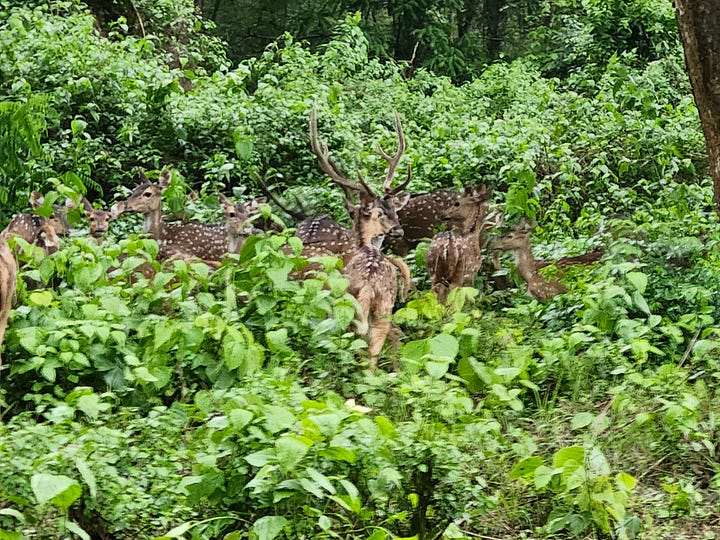
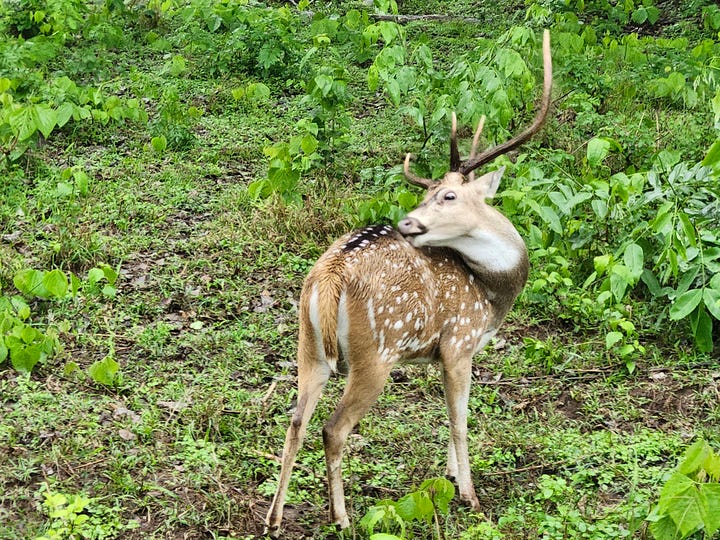
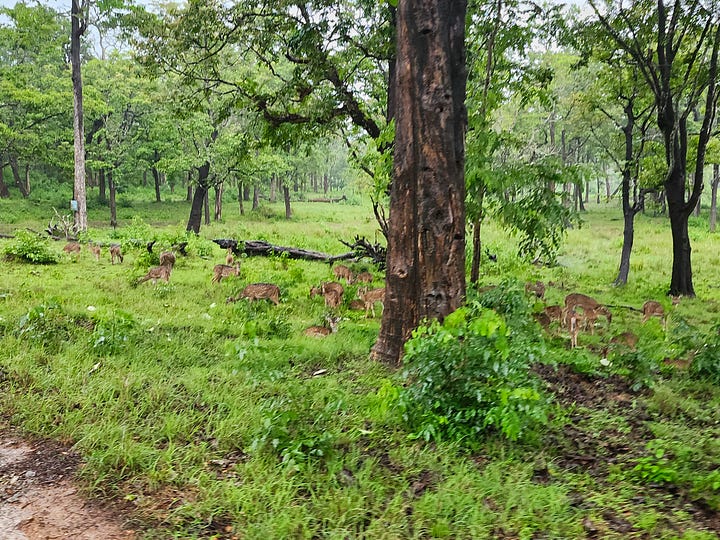

The density of chital (aka spotted deer) was insane, like nothing I’ve ever seen anywhere else. It brought to mind footage of wildebeest in the Serengeti. Seemingly at every other bend in the road, we’d come upon a new group of at least a dozen, a little herd of females and young watched over by a magnificent stag or three. The grass of Nagarahole is lush and rich, fed by good soil plus a water-rich microclimate in this part of the foothills of the Western Ghats, and decades untrammeled by man had created the ideal circumstances for an herbivore species to live long and prosper.

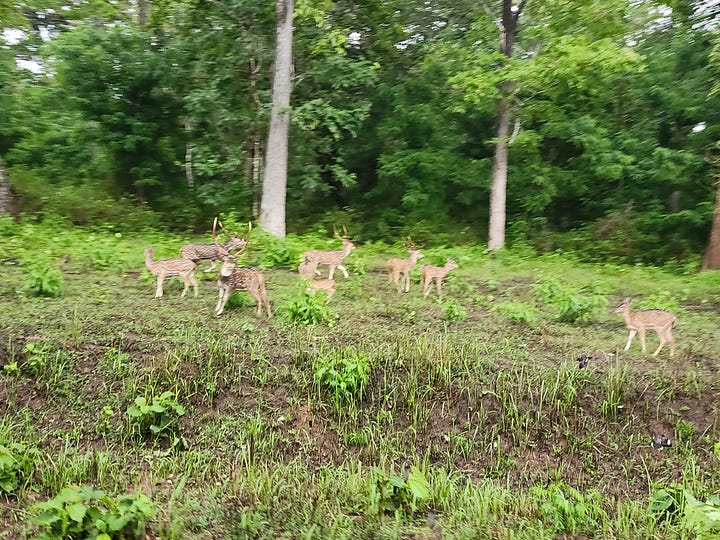
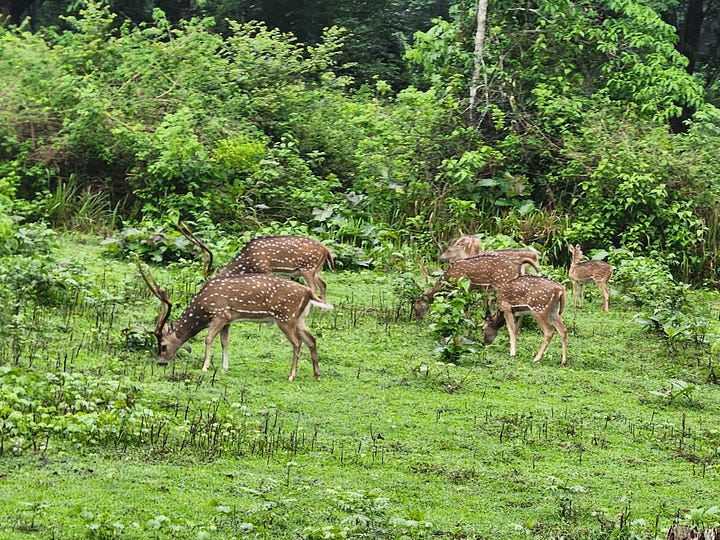
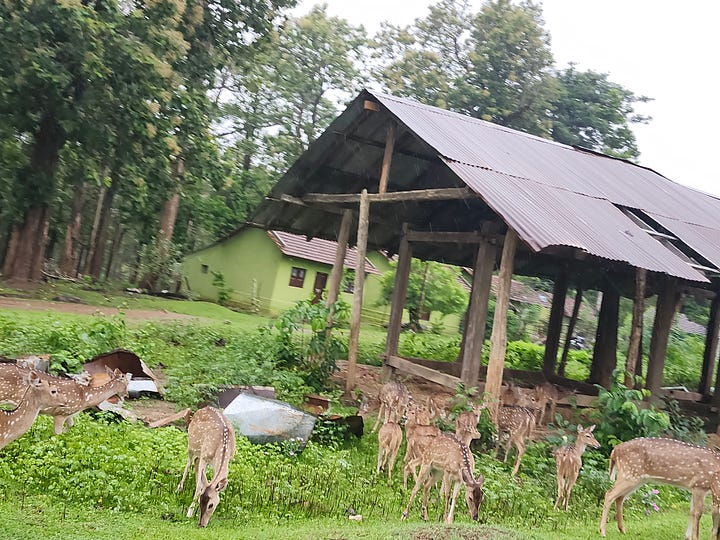
From a distance, the chital fawns could easily have been confused with American white-tailed deer (Odocoileus virginianus), whose fawns lose their similar white spots in adulthood. But they were dramatically unlike many populations of American deer species in a crucial way; they were living in a “fully stocked” ecosystem with substantial large predator populations, sustaining the tigers, leopards, and dholes of Nagarahole. In the wake of America’s mass killings of predators in the early twentieth century, several cases arose where deer populations boomed beyond the carrying capacity of the ecosystem to sustain them. Perhaps most well-known was the case of the Kaibab Plateau in Arizona, where a skyrocketing predator-less mule deer population ate down the vegetation to the point of mass starvation. Nagarahole had a superabundance of deer, but this wasn’t Kaibab-esque manic over-growth abundance: there were lots and lots of chital, but they were within a predator-prey cycle, they wouldn’t be able to breed past the landscape’s capacity to sustain them.
The chital were certainly the most numerous, but far from the only major herbivore I saw on that magical first journey through Nagarahole. On several occasions, our vehicle paused to allow passengers to examine nearby groups of grazing gaur3 (Bos gaurus, listed as Vulnerable by the IUCN). They were magnificent, with rich mahogany coats standing out against the greens of the forest floor and the pale browns of the tree trunks. Their ears were a slightly lighter color, and primed by their general resemblance to domestic cattle my mind kept reading the color difference as ear tags. But these were no livestock: they were mighty titans of the wilderness, striding across the delicious grass of the forest-plain mosaic as their ungulate ancestors had done since time immemorial.
There are two to three bull gaur per herd, and each bull can weigh over one ton, making them the largest wild cattle in the world. However, they may soon be “tied for first” once again on this metric. The aurochs (Bos primigenius), Europe’s similarly-sized rival to the gaur who inspired the bulls of Pleistocene cave paintings, were driven to extinction in the 1600s but efforts are underway to backcross and genetically resurrect them. Still, even as the current largest bovines, they are not invulnerable; a lighter but faster tiger can take down even a full-grown bull gaur.
Globally, the gaur’s population is estimated to be declining, with an estimated 6,000 to 21,000 individuals left, but the Western Ghats region that includes Nagarahole has been one of the securest strongholds for the species in recent years. One 2014 study estimated that there could be over 3,000 gaur in Nagarahole alone!
We saw several other species represented only by one individual: the silhouette of a great vulture on a lakeside tree, the furry blur of a mongoose scampering into the bushes, and near the end of the journey, a wild boar (the same great Eurasian species that ranges all the way to France) on the edge of some shrubbery, and a sambar deer, the chital’s larger, darker brown, and spot-less cousin. Particularly interesting to me was the solitary muntjac, or barking deer, we came across. Taxonomically composed of multiple species, these “mini-deer” range across much of South and Southeast Asia and vary in size from roughly the size of a standard poodle to roughly the size of a golden retriever, much smaller than other deer. A tiny “leaf muntjac” species had been discovered in Myanmar by my childhood conservation hero, the late great Alan Rabinowitz. More recently, I had read that Chinese muntjacs (not this Indian species I saw, but a close relative) had been introduced to Britain, and were thriving in their new habitat.
But the most extraordinary visitation came in the waning minutes of the safari, when we were already on the way back to the park boundary and I had begun to assume that our sightings were done for the day. Then, all of a sudden, in full view by the side of the road, came an unexpected but incredibly welcome sight.
ELEPHANTS! Two tuskless adults (likely both females due to their sociability) with an adorable baby, possibly just a few days old with an incredibly delicate-looking little trunk, sheltering between them. A fourth individual, a tuskless juvenile, stood a little further away; perhaps this was a family grouping. It was the first time I had ever seen these incredibly beautiful, intelligent, and emotionally complex creatures in the wild, and I was absolutely enthralled at the magnificent spectacle. The elephants were eating, plucking leaves and grasses and spooning them into their mouths with their trunks, and it seemed to me to be one of the most thrilling spectacles of natural beauty I’d ever witnessed. I don’t know how long we watched these elephants for, maybe ten or fifteen or twenty minutes, but it felt at the same time like a few too-quick moments and like hours of riveting wonder.
This amazing encounter, combined with the Indian history I’d been reading, got me thinking about the broader context for the human/elephant relationship, particularly in Asia. Chimpanzees, gorillas orangutans, whales, and dolphins have all more or less done their own thing, with most of their pre-modern interactions with humanity taking the form of being hunted and eaten, but Asian elephants have long been closely integrated with human civilizations, especially in India, where they were a core part of a state’s military and transport infrastructure for thousands of years. War elephants were occasionally a transformative factor in the military balance of power across Afro-Eurasia, even though they often panicked when forced into battle and became more dangerous to the side using them then to their nominal opponents. Seleucus I Nicator, one of the generals who succeeded Alexander the Great4, concluded an alliance with Chandragupta Maurya (Ashoka’s grandfather) in which he ceded much of what’s now Afghanistan and Pakistan to the Mauryan Empire in exchange for five hundred war elephants, which were later used to great effect by the Seleucids against a Celtic Galatian incursion into Anatolia. This legacy continued for longer than you might think, from the famous use of war elephants by Carthage against Rome in the Punic Wars to consistently high elephant use throughout India’s history, from the Mauryans to the Guptas to the Mughals to the British Raj. The excellent history book Elephant Company tells the story of the critical role played by elephants in the British Army’s World War II battles against the Japanese in the remote jungles and mountains of Burma. An alien observer of Earth through the last few thousand years might well have concluded that elephants are a subaltern sentient species, alternately hunted and forced into servile roles. In the last few decades, perhaps they would notice that elephants are now occasionally beginning to be granted “reservations” of their own, where humans no longer hunt them.

Returning to the JLR Kings Sanctuary, we watched a documentary about Nagarahole that gave me more context on the rich and complex ecosystem I had just seen. I was particularly interested to learn that in 1974, the Kabini River was dammed, creating a new reservoir adjacent to the park that is now a prized destination for elephants seeking moisture during the height of the dry season. It had rained over Karnataka a few days ago, during my time in Mysore, so the search for water was no longer desperate, (explaining why we had seen elephants in the forest today), but it was still a fascinating datum, another unexpected example of wildlife adapting to the human-changed landscapes of the Anthropocene.
That evening, after an excellent buffet-style dinner, I had a lovely conversation with Manohar, the lodge’s accountant who moonlighted as a nature guide. He was visibly proud of the biological richness of Nagarahole, rattling off statistics that accumulated and harmonized like laurel leaves on an Olympian’s brow: 132 species of birds, and 130 individual tigers recorded in the 2023 Nagarahole census, approximately 1,000 elephants (!), roughly 60 to 70 leopards including one individual with a melanistic “black panther” coat, and “countless” chital in a super-population that might perhaps consist of around 10,000 individuals. And all this in a fast-growing country of 1.4 billion people! Extraordinary.
The next morning, we set off at 6 AM on my second Nagarahole safari. (In India’s dry season, any sensible large-bodied creature will find a shady patch and lay low during the midday heat, so the safaris were held just after dawn and just before dusk).
We had hardly started, passing only a few groups of chital, when we saw one of Nagarahole’s packs of dholes gathered around a tree ahead of us!
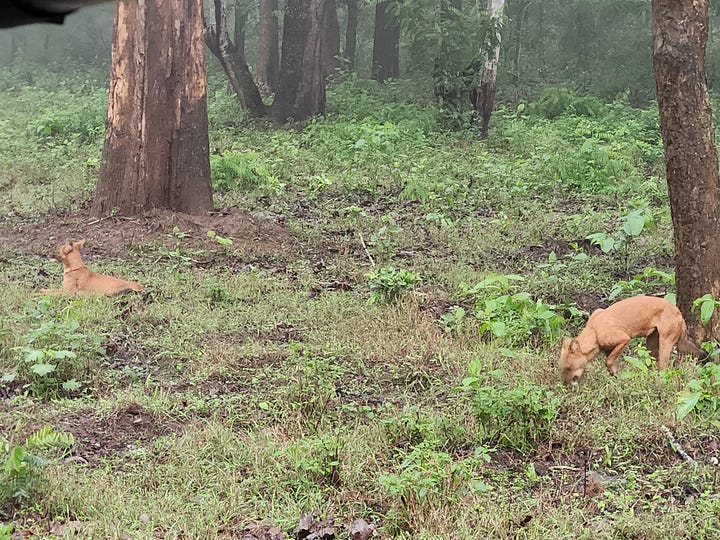
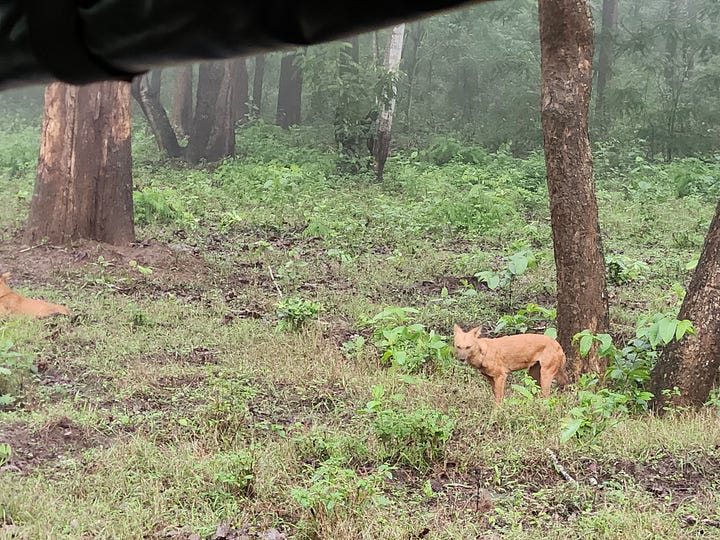
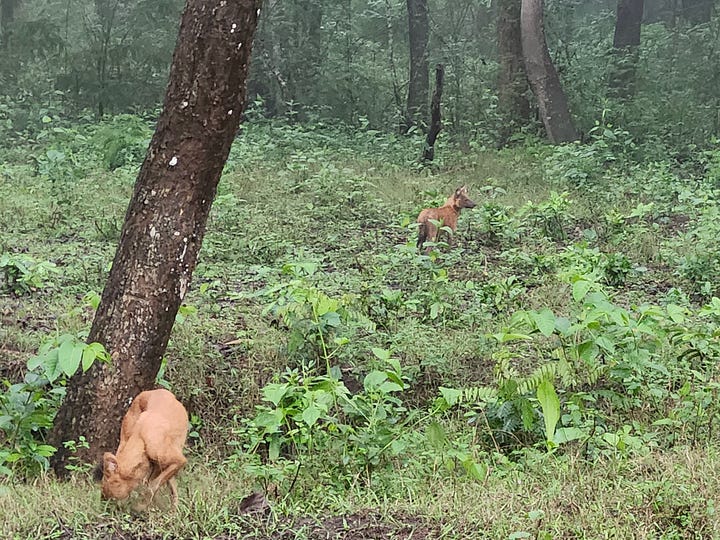
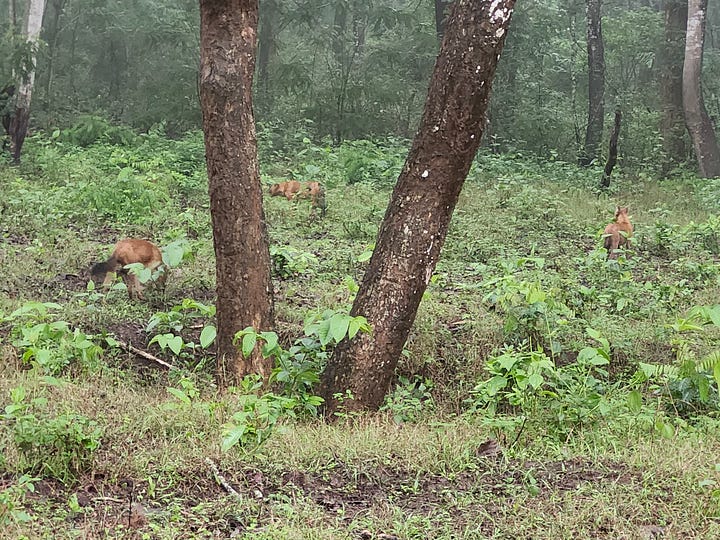
The dhole, or Indian wild dog (Cuon alpinus, listed as Endangered by the IUCN) is a unique canid, reddish-brown with a black fluffy tail. It’s been compared to a long-legged fox, but it’s really its own thing, a unique canid living and hunting in packs that sometimes combine to form large, fluid, highly social “super-packs.” They live in large underground burrow-like dens with multiple entrances and communicate through whistling calls. Although they historically ranged from the tropical forests of South Asia as far north as Siberia, their population has declined substantially due to habitat loss in the twentieth century; there’s no exact count and their numbers fluctuate a lot, but the number of wild dholes in the world is probably somewhere in the low thousands. Nagarahole, thanks to its superabundance of chital deer, is one of the few areas in the world where high densities of tigers, leopards, and dholes coexist.
Luck seemed to be with us that misty morning; barely twenty minutes after parting from the dholes, if that, we were favored by another elephant sighting! This time we saw a single adult individual: as females generally live in groups, it might have been a tuskless male. The existence of such a category may require clarification: in African elephants, Loxodonta africana, males almost always have tusks but some females are evolving tusklessness due to poaching pressure. In Asian elephants, Elephas maximus, females never have tusks, while some males have tusks and some are tuskless.
Interestingly, research conducted in other Indian national parks has found that Asian elephants may be evolving towards tusklessness for all males; due to both the artificial selection imposed by ivory-hungry poachers and the surprising finding that being tusked or tuskless doesn’t seem to be a major factor in winning dominance contests with other males.
He or she trumpeted at us a few times, perhaps mildly annoyed by the pesky photo-snapping hominins oohing and ahhing while they tried to eat their breakfast in peace. I was in awe once again at the flexibility and dexterity of the great trunk, with its complex web of microscopic musculature enabling fields of extraordinary delicacy and dexterity alongside incredible strength.
A little later on we got an excellent view of a crested serpent eagle (Spilornis cheela), the same species Vaibhav had pointed out to me circling above the hills of Sanjay Gandhi National Park in Mumbai. I’m an enthusiastic but strictly amateur wildlife photographer, and on this occasion fortune favored me with one of the better “snapshot” moments I’ve ever experienced, taking a photo just as the eagle launched from a tree into full flight.
The rest of the safari was marked by several breathless intervals when our driver, alerted by langurs’ alarm calls, stopped the car and invited us to closely scan the surrounding area, as a tiger or leopard was most likely present. Despite painstaking observation of every scrap of forest within my field of view, the predator eluded me (and the entire group) for minutes on end. There might well have been a tiger mere tens of meters away from us, but so well hidden by the undergrowth that it might as well have been kilometers. I began to conclude that I was unlikely to see a big cat on this trip to India after all, and resolved to be grateful for the extraordinary natural riches I had already been granted.
Then, finally, in the last hour of the journey, one of these tantalizing near-encounters paid off.
A leopard! I couldn’t believe it: I was seeing my first wild big cat. For precious minutes, I launched a yearning gaze through the tangled canopy, hungrily drinking in the sight of the arboreal marvel resting in the smooth crook of a tree. Leopards often rest in trees, even dragging their kills up there, for a measure of peace and security with less competition from other ground predators. Seeing a leopard in the wild was raw, real, and in both the ancient and modern senses of the word, simply awesome.
This encounter was a culmination of a near-lifelong dream. I’d been absolutely fascinated by big cats since I was a small child, devouring books about them from Spell of the Tiger to Life in the Valley of Death to Dr. Alan Rabinowitz’s Jaguar, probably my all-time favorite book. I’d read conservation news about big cats for most of my life, treasured every chance to include some delicious new research or protected area news about them in The Weekly Anthropocene, and written an in-depth article on how the lion, tiger, jaguar, leopard, snow leopard, cheetah, and puma species were doing as of 2023 and 2024, mostly because I just really wanted to. As a child, I’d even once written fan fiction about a proposed tiger reintroduction to Kazakhstan5. I’ve thought and read and about big cats for years, and now, on May 21 2024, I was seeing genus Panthera in the wild for the first time.
Big cats might be the archetypal symbol of wildness and nature’s Other, the ancient enemy of our australopithecine ancestors, the deadly thief in the night for generations of farmers and livestock herders, the worthy opponent in the ritualized hunting of Mesopotamian kings. The fact that we as a species have decided in some places to let them live their wild lives as we see fit, and expended resources to protect their chance to do so, is an extraordinary testament to humanity’s capacity to grow and change. I see the survival of big cats as a critical indicator of the state of the Anthropocene, a symbol and a reality of whether and how much humans are willing to let, and even encourage, our relative species in the rest of Earth’s biosphere to thrive alongside us on the world we’ve reshaped. In Nagarahole as in many other successful conservation projects, we get a glimpse of what success can look like.
It was by far the “fanciest” night’s accommodation of my India sojourn so far (and the most expensive by almost an order of magnitude, though that still converted to a surprisingly cheap price in US currency), but it was absolutely worth it, indeed worth much more, as the Nagarahole safari was included. I would consider JLR Kings Sanctuary a stellar model of ecotourism and an amazing place to stay, check it out if you’re ever in the Western Ghats area!
And I did so! What I learned in the field with CWS will be shared in my next article from India, which may be delayed a bit as it needs to be reviewed by the organization but will hopefully arrive late next week!
Fun fact: the Red Bull energy drink brand is heavily based off a Thai brand called Krating Daeng, with a name and design based on gaurs. So the gaur, not domesticated cattle, are the original Bulls of Red Bull.
Or Alexander the Accursed as Zoroastrian tradition would have it.
That proposed Kazakh tiger reintroduction may or may not see the light of day someday, but I rather hope my child-self’s fictionalized and heavily dramatized version of it never will.

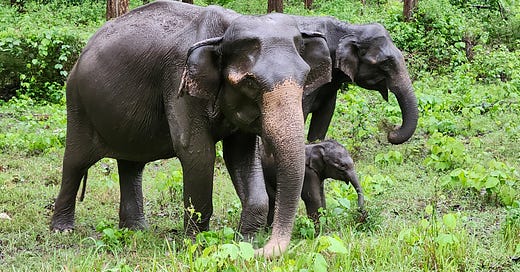






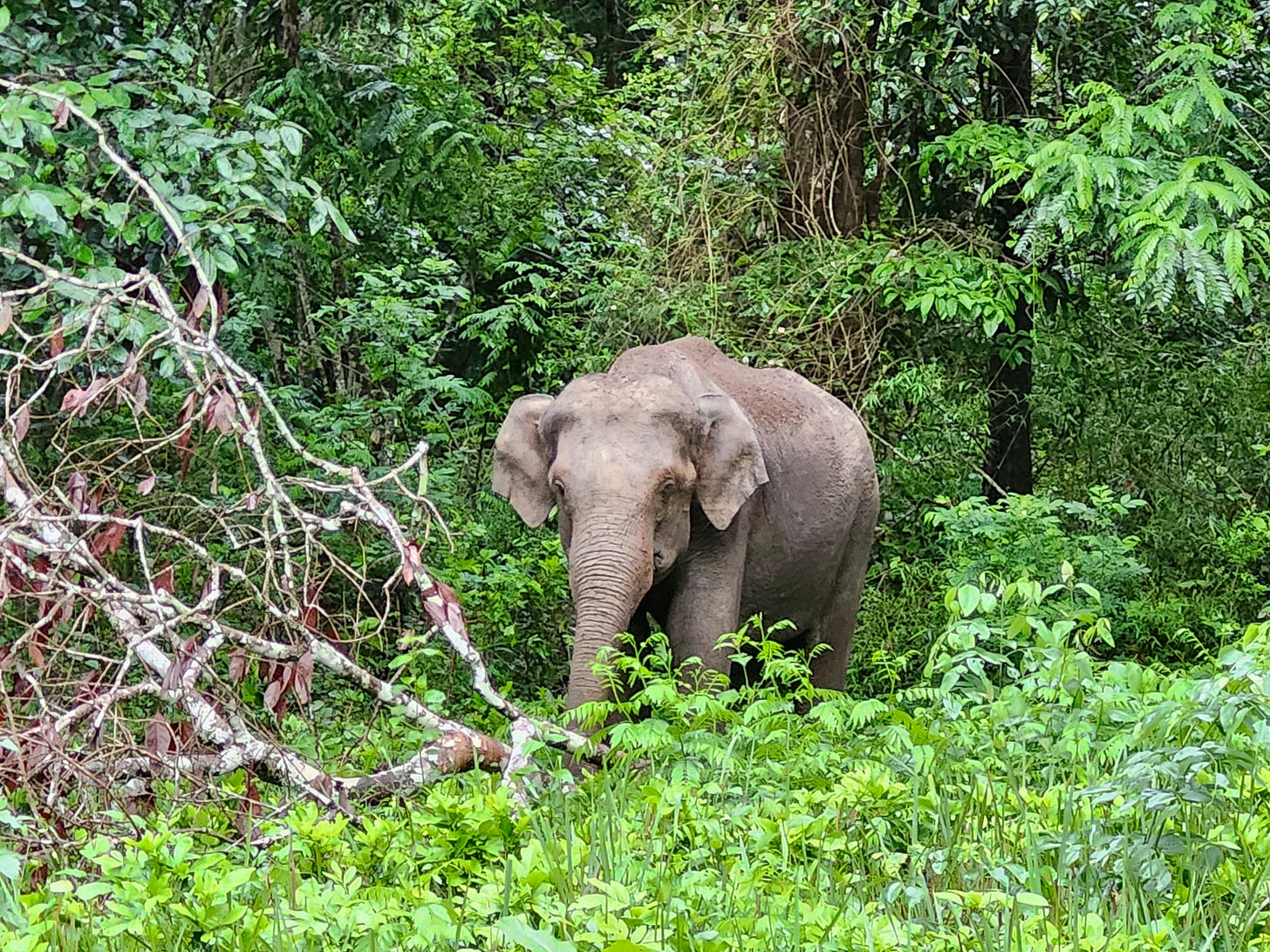
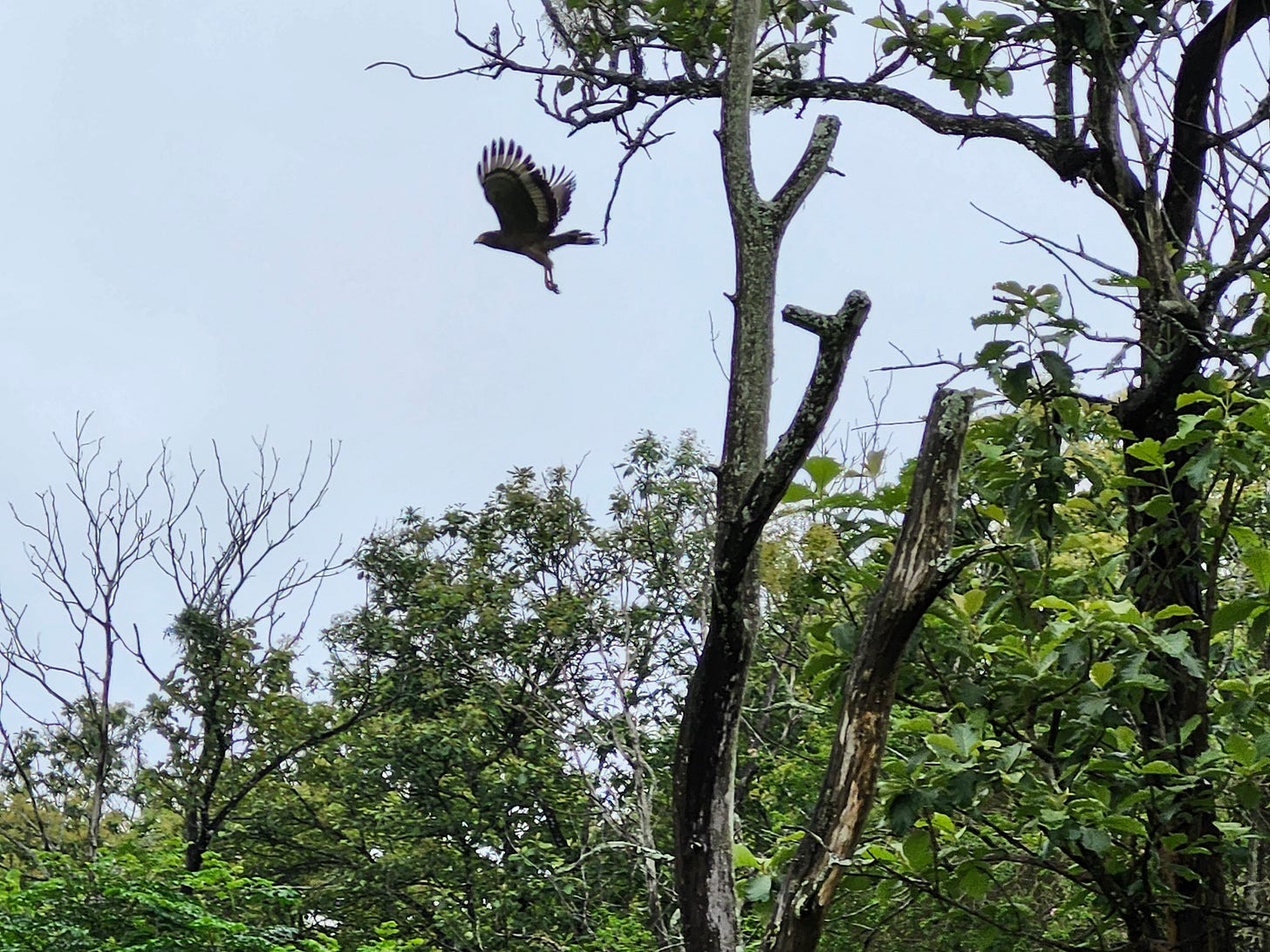
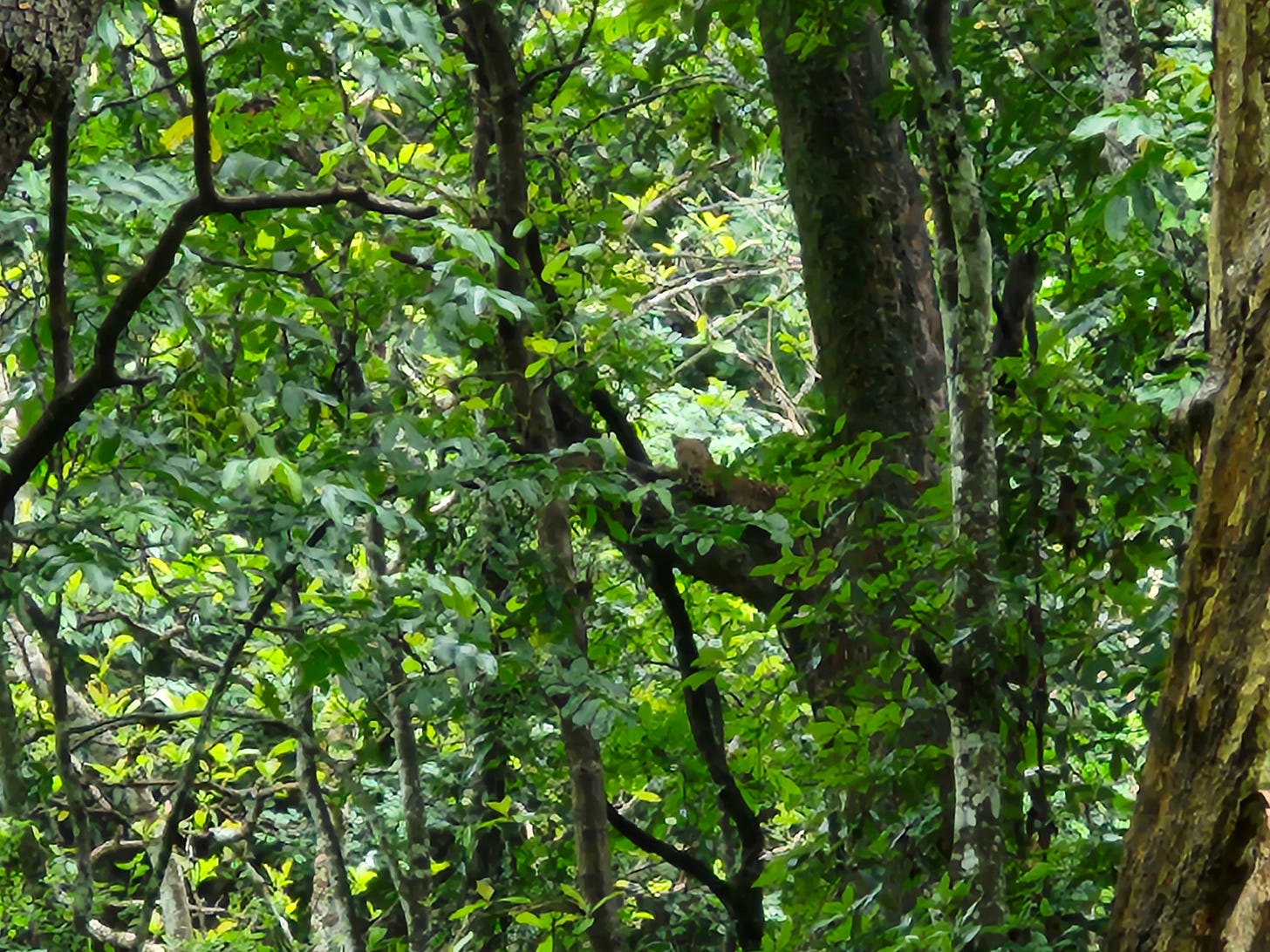
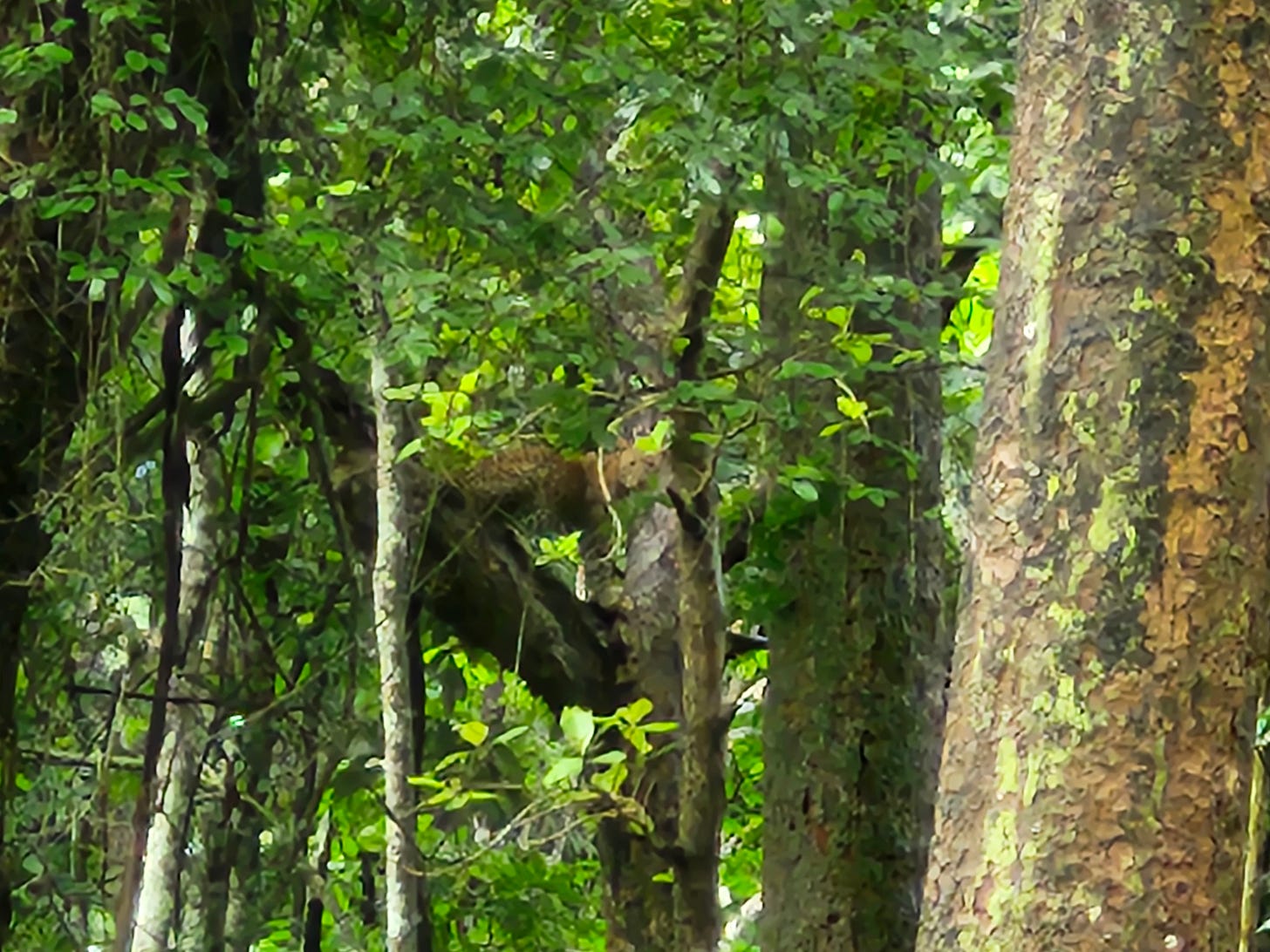
Sam, I honestly have enjoyed this unique account of your India sojourn, in all its installments, as much as anything else I've read in the last year. Your remarks remind me of a younger version of myself decades ago, but smarter and wiser than he was!
I always love it when the footnotes contain some heavy ammunition for Pub Quiz Night.